Can a Square D 9013 Pressure Switch Be Wired With the Line Feeds to the Inside Terminals
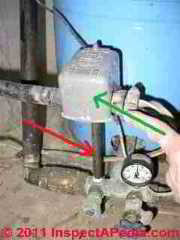 Water Pump Won't Turn On
Water Pump Won't Turn On
10 checks for a water pump that won't start - no water pressure
- POST a QUESTION or COMMENT about diagnosing, repairing, or replacing well pump pressure controls
InspectAPedia tolerates no conflicts of interest. We have no relationship with advertisers, products, or services discussed at this website.
Why won't the water pump run?
This article provides a diagnostic checklist of the reasons that a well pump or water pressure booster pump won't start or won't run when it should.
This article series describes how to repair a water pressure control switch that sticks on, off, or chatters or is otherwise not working properly, causing loss of water pressure or irregular in cycling on and off.
We discuss how to diagnose problems with the water pump control and how to fix them by correcting an underlying problem, by replacing a bad pressure control switch, or by replacing switch parts such as bad contacts or diaphragm.
We also provide an ARTICLE INDEX for this topic, or you can try the page top or bottom SEARCH BOX as a quick way to find information you need.
How To Diagnose & Fix a Water Pump That Won't Start or Won't Run
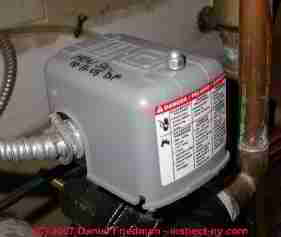
This article explains inspecting, cleaning, and possibly repairing a typical Water Pump Pressure Control Switch or other controls or problems when a water pump or well pump won't start or won't run.
[Click to enlarge any image]
For most well water or water pressure boosting systems, a pump pressure control switch, usually found close to the water pressure tank, senses the water pressure and when necessary, turns the water pump on.
The water pump pressure control switch either turns on the water pump directly, or (particularly when a submersible water pump is in use), this switch may operate a physically separate (usually wall-mounted) heavier-duty pump relay which turns on the water pump itself.
If water pressure shown on the water pressure gauge falls below the pressure switch CUT-IN pressure and the pump won't turn ON there could be several causes and fixes that we will describe in this article.
As we will also explain, some well or water piping or water pump control problems can cause both pump-start and pump-stop problems.
Article Contents: Water Pump Won't Turn On - 10 diagnostic steps
- CHECK WATER IS TURNED ON
- CHECK ELECTRICAL POWER
- CHECK WATER PRESSURE GAUGE
- CHECK for STUCK PRESSURE CONTROL RELAY
- CHECK RESET SWITCH / BYPASS LEVER (not present on all controls)
- CHECK PRESSURE CONTROL BASE CLOG or TORN DIAPHRAGHM
- CHECK PRESSURE SENSOR TUBING CLOGGING
- CHECK PRESSURE SWITCH RELAY CONTACTS
- CHECK for OVERHEATED PUMP MOTOR
- CHECK for DAMAGED PUMP WIRING
Water Pump Won't Start - If the Water Pump is Not Turning ON Try These Steps:
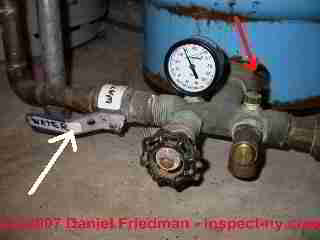 If your well pump won't start,
If your well pump won't start,
1. Confirm that water into the building is turned on
Check that there is no shutoff valve in the OFF position (off is fully clockwise) between the water supply and the building water piping.
Then turn on water in the building and watch for a pressure drop at the pressure gauge - as pressure falls below the control switch CUT-IN setting, the water pump should turn on.
Typically that's a pressure of 20 or 30 psi.
If you can't find the main water shutoff valve for your system
see WATER SHUTOFF VALVE, WELL
2. Confirm that the pump electrical power is on
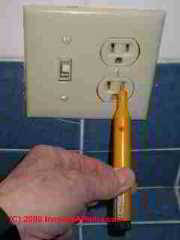 If you have not already done so, you should determine that you have electrical power at the pump. Be sure that the pump electrical power switch is in the ON position.
If you have not already done so, you should determine that you have electrical power at the pump. Be sure that the pump electrical power switch is in the ON position.
If you can't find the pump switch
see WATER PUMP ELECTRICAL SWITCHES.
Watch out: it is possible to use a DMM or VOM or a simple voltage tester to confirm that electrical power is being delivered to the pump relay or control switch.
But if you are not trained in basic electrical work and testing you could be shocked or killed - it's best to leave that step to a licensed electrician.
If you are capable of simple electrical testing but need a low-cost tester
see TEST EQUIPMENT, ELECTRICAL.
Also see DMMs VOMs SAFE USE OF.
The voltage tester we show here is one of the more-safe instruments as you do not need to actually touch an electrical wire or contact to confirm that it is carrying current.
3. Check the water pressure gauge
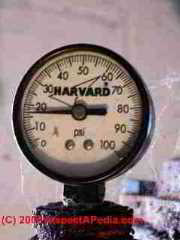 Look at the water pressure gauge reading.
Look at the water pressure gauge reading.
If water pressure on the gauge is below the water pump control cut-in pressure
In our water pressure gauge photo at left we show a pressure of about 17 psi. Since this is below our water pump cut-in pressure which was set to a little over 20 psi, the pump should have cut on. Something was wrong.
If the water tank pressure gauge reads a low number, say below the pump's cut-in pressure, try tapping the gauge gently to see if the indicator needle moves.
Watch out: The same sediment that clogs pump control switches also clogs water pressure gauges.
So your gauge could be wrong.
You can purchase or make
a WATER PRESSURE TEST GAUGE [photo] that connects to a hose faucet anywhere in the system if you want to double check for this problem.
If water pressure on the gauge is above the pump's CUT-IN pressure
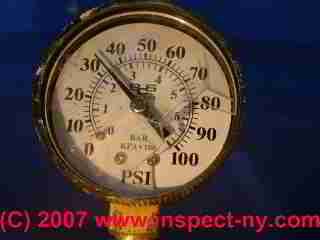 When the water tank pressure gauge reading is above the water pump's "cut-in" pressure (say 32 psi as we show in the photo below), don't expect the pump to turn on.
When the water tank pressure gauge reading is above the water pump's "cut-in" pressure (say 32 psi as we show in the photo below), don't expect the pump to turn on.
In that case, run some water in the building, watch the gauge pressure fall to below the pump's cut-in pressure, and then we should hear the pump turn on.
- If the water pump is in the well (a submersible well pump) you won't hear it running, but you can hear the pump relay click in and out (close or open) and you can see the water pressure change at the gauge when the water pump is running.
- If the pump runs and water pressure is present in the building but the water pressure gauge pressure never changes, it's probably the water pressure gauge that needs replacement.
You can replace a water pressure gauge following the same procedures we outlined
at PUMP PRESSURE CONTROL REPLACE.
4. Check that the pressure control switch is not stuck
Debris or silt clogging can prevent a water pump pressure switch from properly responding to changes in water pressure.
So water pressure can fall as you use water but the pump may fail to turn on when it should (when pressure falls below the CUT-IN setting) or it may fail to turn off when it should (CUT-OUT setting) or it may fail to respond just sometimes.
Tip: Try tapping on the water pressure control switch. If the pump turns on then it may be debris clogged.
Burned control relay points in the pressure switch may also prevent good electrical contact and can make the pump switch behave erratically.
If the water pressure gauge stays low (below the pump; cut-in pressure, try tapping on the side of the pressure control switch housing itself. Don't bang it with a hammer, just tap it.
If the pressure control relay switch closes and turns on the pump after you tap on it but if it otherwise sometimes "sticks" in the "off" , there's probably a problem with the pressure control.
It could be a dirty or burned electrical contact, a loose electrical connection, or debris clogging the diaphragm of the pressure sensor (or something else we haven't thought of).
Tap on the water pump itself
If the pump is accessible we might give it a smart rap with a small wrench. Don't bang it with a hammer.
Just as a connection in a pressure switch may be loose or dirty or bad, the same could be true of a pump motor. If tapping on the water pump makes it start, it needs repair or replacement.
5. If Present, Try the Pressure Control Switch Re-Set or Manual or Bypass Lever - if your pressure switch has one
 Some pressure control switches include a metal lever along one side of the switch.
Some pressure control switches include a metal lever along one side of the switch.
Lifting this lever from its horizontal (off) position upwards towards vertical (on) position, will "force" the pump switch to turn the water pump on. We explain the intended function of this lever-switch just below.
In our pump control drawing (left) the red arrow points to a pump pressure control switch bypass lever. Most pump pressure control switches do NOT have this feature, however.
Provided that you also have electrical power at the switch, the well pump should turn on if you lift this lever.
Some manufacturers such as Square-D call this the "Maintained Manual Cut-in Lever or Manual Cut Out Lever" (depending on the switch model and application).
"Manual cut in" means that lifting the lever will turn on the pump.
Watch out: Do not leave the manual cut-in switch on (up). Turn the switch back off and proceed to diagnose why the switch was not turning the well pump on and off automatically.
On Square-D pump control switches that contain the lever you describe, includes a low-pressure cut-off feature intended to protect the pump from damage should the well run out of water.
The model involved might be, for example, the Square D by Schneider Electric FSG2J24M4CP 40-60 PSI Pumptrol Water Pressure Switch with Low Pressure Cut-Off.
The normal position of the lever is DOWN.
The lever can be lifted to force the pump to run, a feature that is sometimes used during installation or maintenance. Here is an example of how the switch is used.
If there is no water pressure and the pump has shut off - or is not running - in response to the fall of pressure below the pump switch cut-in pressure, then the switch may have tripped OFF to protect the water pump from damage that can be caused if the pump runs dry - without water. In that case do the following:
A. If the pressure is below cut-in, and the switch has low pressure cutout (Form M4), [lift and ] hold lever in the Run position.
1. The pump should turn on and run.
2. When you release the lever, if the M4 feature cuts out the pump again (within 10 psi of cut-in), the water source is low.
3. Do not actuate the M4 lever again until source has recharged (the well has water in it). [You may need to wait several hours or longer]
B. Where Form M4 [the side lever and pump protection feature] is not present, check the water source. The well may be low. Turn off the power to the pump until source has recharged (the well has water in it)
The document cited just below offers a brief maintenance and troubleshooting guide for class 9103F and 9103G pressure control switches, including how to use the manual over-ride side-lever on a Pumptrol switch.
- "Preventive Maintenance and Troubleshooting Guidelines for Class 9013F and 9013G Pressure Switches", [PDF] Square D, Schneider Electric USA 8001 Knightdale Boulevard Knightdale, NC 27545 USA 1-888-SquareD (1-888-778-2733) www.us.SquareD.com (2007)
6. Check the pump pressure control switch for pressure sensor clogging or failed diaphragm
 If your well water is high in iron, sediment, or minerals, we find that sometimes the small diameter pipe that mounts the pressure control switch onto the water line, water pump, or water tank will clog with these materials. In the photo at left I'm pointing to the pressure control switch.
If your well water is high in iron, sediment, or minerals, we find that sometimes the small diameter pipe that mounts the pressure control switch onto the water line, water pump, or water tank will clog with these materials. In the photo at left I'm pointing to the pressure control switch.
You can see the small diameter mounting pipe that connects the bottom of this pressure switch to the building water supply piping right at the bottom of the water tank.
Other pressure control switches may be bolted right to the pump motor and may use a flexible plastic or copper tube to transmit water pressure to the switch.
If this pipe (usually ¼" or 1/8" IPT diameter) is clogged with debris, you might be successful in getting the pressure control switch working again by removing the control switch, confirming that the line is packed with debris, and replacing it.
BUT
In our experience often when there is enough debris to clog the pressure control switch mounting pipe then the same debris also clogs the still smaller opening in the bottom of the pressure switch itself.
It's this small opening that permits water to press against a diaphragm in the bottom of the pressure switch and thus allows the switch to sense the water pressure.
Watch out: the pressure sensing diaphragm on the bottom of the pump pressure switch is the mechanism that senses water pressure. If the diaphragm has developed a tear or old the switch may leak water and it certainly won't work.
The repair kit discussed
at PRESSURE SWITCH REPAIR KIT may solve this problem or you can simply replace the switch. Do so if it's leaking from the switch body.
7. Check for Problems with the Tubing Connecting the Pressure Switch to the Water Piping or Water Tank
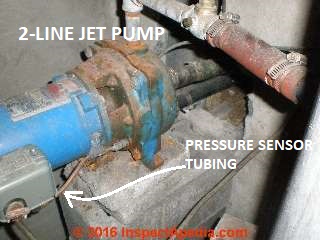
Debris can clog the tubing connecting (or mounting) the pressure control switch to the water tank or water piping, preventing the pressure switch from responding properly to changes in water pressure.
The result may be intermittent failure of the switch to turn the pump on or off, or it may result in a hard failure to turn the pump on or off.
Our photo shows a copper tube running from a two-line jet pump (photo center) to the bottom of a pressure control switch (the gray box at lower left). This is the tube that carries water pressure (pressurizing air in the tubing) to the bottom of the pressure control switch.
Pressure Control Switch Tubing Clogging
Clogging of the Water Pump Pressure Control Switch
if your water has a high level of silt, debris, or minerals, it's possible that the tubing or piping connecting the pump pressure switch to the pump or water piping, or the pump switch bottom orifice through which the pressure switch senses the water pressure in the system has become clogged.
The small diameter of this tubing and still smaller diameter of the pump switch orifice makes clogging easy if your well water is high in sediment or minerals.
A clogged water pump pressure control switch will often fail to turn on the well pump at all, even though the pressure in the system has dropped below the water pump "cut in" pressure. Reader Jeff Crosby reported an example of this pressure switch clog problem:
[When our well pump kept short cycling and I was unable to get the well pump pressure control switch to work properly, ...]
I ended up calling the pump service company to come over. There was an extreme amount of mineral buildup inside the pump where the copper tubing initially comes out to travel to the pressure switch.
I thought about checking that out but did not know how funny. There has always been an awl sitting on the pump base for the longest time.
One of their maintenance guys left it there long ago.
Now I know why - ever since that date when they come do their yearly check up they knock out this sediment [using the awl to open the tubing so that the pressure switch can accurately sense the water pressure in the system]. -- Jeff Crosby
On rare occasions we can tap on the well pump control switch and it will begin working again, but not for long, and not reliably. Another water pressure control switch failure is the rupture of a rubber disk or "bladder" inside the switch itself. If you detect or suspect a defective pressure control switch, try replacing it with a new one.
We see a similar problem affecting water pressure gauges on private water systems: debris or mineral deposits can clog the pressure sensing orifice on the water pressure gauge, causing it to fail to respond at all, or to respond inaccurately to changes in water pressure.
When we find a clogged water pump pressure switch or the tubing connected to it, or a clogged water pressure gauge, we replace those items. A well pump pressure gauge that does not respond to pressure changes is potentially unsafe as it could lead to excessive pressurization of the water tank and building piping.
Pressure Control Switch Tubing Leaks
Thanks to reader Bob Hartman-Berrier for explaining a more subtle problem with pressure control switch tubing - wrong (too-small) diameter, causing a leaky fitting, preventing the pressure control switch from properly responding to changes in water pressure.
The tubing connecting a pressure switch may be steel (a rigid small-diameter mounting pipe), flexible copper (connected with flare fittings), or flexible plastic (connected using special brass connectors. Changing the tubing, especially plastic tubing, can get cause trouble.
Mr. Hartman-Berrier diagnosed this problem by observing that the pressure control switch would turn the water pump on if the override lever on the pressure switch were moved to the "on" position, but otherwise the switch did not work.
The pressure switch was not turning on the water pump even though the water pressure was below the "cut-in" pressure setting. Because the pressure control switch was a new one, investigation eventually turned to a possible problem with the plastic tubing connecting the switch to the water tank.
... the pump would not come on by itself but it would come on if I used that over-ride switch. The replacement tubing between the pump pressure sensing diaphragm and the pump body was not small enough on its inside diameter to make a tight seal on the nipples of the switch and the pump body.
The seal was tight, but not tight enough; the hose didn't blow off, but it wouldn't allow the pressure to build up in the tube and on the pressure sensor.
For a proper fit and thus for the pump pressure switch to sense the water pressure in the plumbing system, the internal diameter of the pressure tube must match the fittings to which it attaches.
I was worried about the outside diameter, thinking the inside dimensions of the new tube would be the same as the old one. It wasn't.
I was also worried about "priming" the pressure sensing tube and the pressure switch diaphragm, thinking that because any air in the tube is compressible and that the diaphragm wouldn't be activated because the air would keep compressing.
This was a mistake. The volume of air at higher pressure will be reduced, but the air pressure and water pressure will always be the same.
[BOYLE's LAW - also
see WATER TANK PRESSURE CALCULATIONS].
I changed the hose (more-or-less proper ID), plugged in the pump and - miracle of miracles - the switch turned on. Its been running fine since then, and we've had plenty of water and pressure.
Watch out: your water pump might have two tubes running from the pump body: one tube carrying pressure to
the PRESSURE CONTROL SWITCH, [photo]
and a second, similar-diameter tube that is connected between the pump body and
an AIR VOLUME CONTROL [photo].
AVCs are discussed
at WATER TANK AIR VOLUME CONTROLS.
How to Check the Bottom of the Pump Control Switch for Clogging
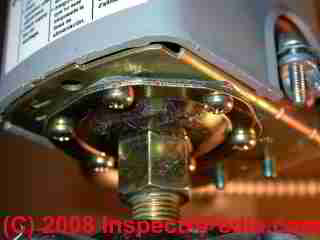
If as long as we're taking the switch off to check these things I'd check out that opening on the switch bottom as well.
We do this by unscrewing the connecting pipe from the bottom of the pressure switch, and looking inside of the opening into which that pipe was connected.
In a pinch it's good to know that you may be able to clean the water pump control switch right up and get it working again.
Be careful about poking anything into the threaded opening which connects the pressure switch to the water pump or water tank. It's tempting to just jam a paper clip into the little sensor hole and wiggle it around. But if you puncture the switch diaphragm you'll certainly need a new switch.
You probably need one anyway if you see a lot of crud in there.
It's possible to remove all of the phillips-head screws you see in this photo of the underside of a pump pressure control switch, to expose the diaphragm, and to clean out the whole mechanism. Don't tear the diaphragm
Since a new pressure switch is not very costly, and since we have to take the switch off to diagnose it anyway, if on removing and inspecting the pump pressure switch we think it was clogged, I'll often just replace it.
8. How to Check & Clean the Well Pump Switch Contacts

Check the water pump pressure control switch for dirty, burned contact points:
If the pump pressure control switch contacts are burned we can sometimes get it working again for a while by first, turning off electrical power as we described above, and then using a file, carefully cleaning all touching-surfaces the switch contacts.
A file may produce less grit and debris in the switch than sandpaper.
We sometimes use fine sandpaper anyway, but in either case be careful not to leave grit and debris in the switch or it'll fail again that much sooner.
If after inspecting the pump pressure control switch or its mounting fittings you decide that you've repaired it or that you need to replace it, follow the instructions
at PUMP PRESSURE CONTROL REPLACE for reinstalling the control.
Watch out: do NOT try working on a pump control switch without first removing electrical power - you could be killed by electrical shock.
Causes of burned pump pressure control switch contact point surfaces include:
- Old pressure control switch, long usage
- History of pump short-cycling on and off too frequently -
See WATER PUMP SHORT CYCLING
- Switch installed in a wet location or one where corrosive gases are present (pool chlorine)
- Prior attempts to "clean" the points surfaces by filing or sanding (works only temporarily)
If the pressure control contact point surfaces are burned, it may interfere with the pump turning on.
While it is possible to clean or even file these surfaces to get the switch working again as an emergency temporary fix, the switch needs to be replaced.
While we have heard a report of the pump pressure control switch failing to turn "off" blamed on burned contact points, we think that when a pump won't turn off other causes are more likely.
9. Check for an overheated water pump
If the pump has run continuously for hours it may be overheated. Some water pumps, particularly submersible (in-well) pumps include a thermal overload switch that will turn the pump off if it overheats.
Submersible pump overload switches will re-set automagically when the pump motor cools down. Try waiting half an hour. if water pressure returns this might be the problem. (Or your well was also running out of water.)
A pump with bad bearings, a failing motor, or that is receiving low voltage can also overheat and shut off on thermal reset.
10. Check for open wiring to a submersible well pump
If there is electrical power to the pump controls but the pump does not turn on, wiring between the pump control and the pump motor could be cut, damaged or open.
Watch out: damaged electrical wiring is unsafe, risking fire, electric shock, or even death. Get help from a licensed electrician to test wiring to the pump for continuity, resistance, unusual current draw, or other damage.
No water and no pump working following a power failure
I had a power failure today and now that the power has returned I still don't have water. I reset the breakers just in case with no effect. The pressure gauge next to the switch still says 50psi but no water is coming out of the taps. Never had a problem with this system before.
It is a pumptrol like in your picture. It doesn't have a lever on the side like I've seen in other pictures. Any ideas? - Alex D 8/18/11
(3 days ago) Anonymous said:
Have square D pressure switch 9013FSG2M4 on 1 hp elect pump; water from aerator to house through 35gal pressure tank (rubber diaphragm). works fine normally ( 35psi to 55psi) except when lose electricity.
If pressure drops below 20psi before the electricity returns; when elect. returns pump appears to start but switch contacts open. I have to hold contacts closed until pressure builds to 30 psi for them to stay costed. Why? What is solution?
Reply:
Alex:
Following a power failure or a lightning strike there are a number of possible sources of well and pump trouble. Starting with the clues in your question.
As your gauge says your system is at 50 psi but yet you have no water coming out of the taps, I wonder if the pressure gauge (and thus potentially the pressure control switch too) are dirt clogged and not registering pressure changes
- try tapping on the gauge to see if it moves; replace a clogged gauge, pressure switch, or mounting pipe nipple or plastic line feeding water pressure to the switch sensor.
Have your electrician or other expert check for the presence of voltage at the pump and control switch
Check for a lightning strike that shorted wiring, burned wiring, or damaged the pump motor - see
- ELECTRIC MOTOR DIAGNOSTIC GUIDE
- DMM DIGITAL MULTIMETER HOW TO USE
Anon
It sounds as if the electricity loss means you are losing prime in your pump - check first for a bad foot valve or check valve.
Lightning Strike Effects on Pump & Pump Switch
Curious, Ez.
If your power outage was caused by a lightning strike the pump or pump wiring could have been damaged. Some well pumps that intend to run at 240V might limp along at low voltage. So I'd start by asking your electrician to check the voltage being supplied to the pump and its controls.
Keep us posted; what you learn will also help others.
Matt: Please search InspectApedia.com for INTERMITTENT LOSS OF WATER PRESSURE to read the diagnosis and cure of the problem you described.
Private water bore - We had a power outage for several hours (electricity company updating their system) and since resumption, the water pressure is lower.
I noticed it because the hot water pressure is half of what it was before the outage, the cold is always strong and is more than adequate (but not strong enough to push the hot water at a reasonable flow).
I know virtually nothing about how this all works except I have a submerged pump located several meters from the house in the garden. in the loft I have a large plastic storage rank, a large 3' pressurised metal tank with a gauge on it, and an electric box with LEDs that cycle on and off;
in a cupboard I have a pump on and off switch, a pump isolator switch, and switch labelled by the previous occupier as 'overload switch'.... so where do I start to diagnose the problem? Thanks
Reader Q&A - also see the FAQs series linked-to below
On 2022-04-29 by Inspectapedia Com Moderator - no water from the well of vacant house
@Angie,
Your son might want to read the steps given above on this page - In my OPINION that's a perfectly-reasonable place to start.
Next if he needs more diagnostic steps he can move on to
NO WATER PRESSURE - other causes besides a bad pump or pump control
My son just moved into a house that has been boarded up for 8 yrs. He lived here when he was little. Well there's no water. What should he check first with the Well and is it because there hasnt been anyone here for so many years?
He said it worked when they moved. Thats all he knows and he's 21 and knows nothing about Wells so when responding just know neither of us know about Wells lol. Thank you.
On 2022-04-19 by Inspectapedia Com Moderator - wiring error
@Nonnie,
From your description it's likely that there is a wiring error somewhere or a short circuit - a wire inadvertently grounded.
An example of how this can happen that one might miss: over-tightening a strain relief clamp where the electrical wire passes into the switch - cutting into the wire and shorting hot to neutral or to ground.
Keep us posted.
my husband just replaced the power switch but now the power breaker keeps tripping. He's tried reversing leads and everything he thinks might work but to no avail.
On 2022-03-29 by Inspectapedia Com Moderator - cleaning wires fixed pump that unexpectedly quit
@Garth,
Wow. Good news. Let's hope that simple repair proves lasting.
@Inspectapedia Com Moderator, I dismantled the electrical side of things (after turning the circuit breaker off), cleaned the wires (slight corrosion) and put it back together.
Turned breaker back on and all is once again working. I was hoping it wasn't pump issue. The tank and pressure switch were replaced within the past year so I figured they were ok. Thanks for the guidance.
@Garth,
Even when you're not running water (though you might be without realizing it, such as a running toilet), the well pump might try to turn on in order to re-pressurize the system.
If a foot valve is leaky the water runs back into the well from the pressure tank, the pressure drops, the pump turns on.
If that cycling combines with a well that is running out of water or has a poor recovery rate, the pump starts to draw air rather than water
And in that case if there is a pump protection switch that may open to turn off the pump.
If instead, the switch that you re-set is a circuit breaker I'd suspect pump motor damage as well as loss of water in the well.
More details of the cause and repair for a pump that won't run are in the article above, so please take a look there.
A trained service tech can make some simple tests of the current draw of your pump that might tell us if the motor is seized, running but pumping air, or off completely.
Keep us posted, as what you find will help other readers.
My well/pump just quit during the day with nothing using water. Had to reset the control box reset switch, unit came on ran for a few moments with lots of air and then shut off again.
Checked the pressure switch and the contacts are closed, the gauge reads 0 psi and there is 216VAC going to the pump wires. The pump is submerged at 187 feet. Everything appears to be correct, but no pump operation.
On 2022-03-12 by Inspectapedia Com Moderator - right air pressure but wrong air volume
@Brian,
I don't think this is exactly a pressure tank problem - though if condensation reaches near the top of the tank, indeed it's water-logged ( a condition that can cause pump short-cycling).
Your tank might have the right "pressure" of air but not the right air volume. You want the tank air pre-charge to be 2 psi below the CUT-IN pressure when the pump has been turned off and all water pressure has been drained from the system.
Rather when the pump turns off before reaching the cut-off pressure I suspect the well is running out of water and the pump is being shut off by a pump protection switch OR the pump itself is overheating or failing.
When I start my pump, it builds pressure to about 30psi and then shuts off and will not cut on again and I have to restart it and ends up same results. I've tried 3 different pressure switches.
My pressure tank has the correct air pressure in it. There's a lot of condensation on my pressure tank that I have never noticed before. Any suggestions on what to do
@Randy,
Probably one of the reasons listed above on this page - that's my most complete list of diagnostic guesses.
Examples excerpted from above: even a new well pump installation can have a leak that loses prime or debris that temporarily blocks the sensor port on the pressure control switch. Of course check also for a poor electrical connection.
Deep well 265', New pressure tank, tee, gauge and pressure switch. System worked fine several cycles after installation. Next morning, no water, 0 pressure.
Manually started pump at pressure switch, Pressure restored to set pressure of 50psi. Pump shut off as expected. No leaks detected. Why didn't pump cut on at 30psi automatically?
On 2021-10-01 by inspectapedia.com.moderator - pump won't start after power outage
@Marcel de de Bie,
I don't know, of course, being so far away and just seeing a brief text, but I'm guessing that your system has a leak in well piping or a leaky foot valve.
When you had electrical power and ran no water in the building water drained back out of that leak but the pump could come on and recover pressure .
When you lost electrical power for sufficient time for the water to drain back enough to lose pump prime, when the pump returned to service it had lost prime so ran dry until it was damaged, or shut down by a pump protection device. (Assuming your pump is above ground?)
If there is a small leak in a water system and there is a power cut then the water pressure continues to drop during the power cut and eventually drops below the switch on point of the pressure switch. When power is restored the pump will not start because the water pressure is too low. Any solution for this?
Wiring diagram
On 2021-05-28 by danjoefriedman (mod) - how to reset pressure control switch settings
@Ron,
Having fouled up the pump pressure control settings in the switch myself, we've now got an article on how to get back to a reasonable starting point: factory settings.
I've detailed just how to get back to pressure control switch settings of 20/40 CUT-IN / CUT-OUT or to 30/50 at
WATER PUMP PUMP PRESSURE SWITCH STANDARD (PSI) SETTINGS
Please take a look and don't hesitate to ask follow-up questions
Water pump settings all screw up how to reset them
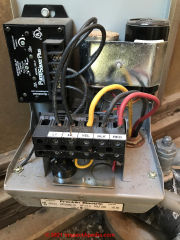 @Greg, could be a blown capacitor or other electronic component in that PumpSaver pump protection device;
@Greg, could be a blown capacitor or other electronic component in that PumpSaver pump protection device;
Try this: right on the PumpSaver Plus you'll see a calibration dial that may need to be re-set.
Here is are some diagnosis and repair excerpts from example instructions for a this series of PumpSaver controls
OFF / MANUAL RESTART: The pump is not running. Either the PumpSaver® has tripped on dryrun, dead-head, or overload while the RESTART DELAY/ CALIBRATION knob was in the If knob is in the RESET position, rotate out of RESET—If the CAL light blinks, check for an overload condition. If the RUN light blinks, look for a dry-run or dead-head condition. If no lights come on, check incoming power for adequate voltage.
RESET position or source power is not present.
Also double check that there's no other pump motor reset button somewhere.
See details about your Pumpsaver, 230V 1Ph, 1/3-3HP, Surface Mount control and find the IO manual for it as a free PDF download
at WATER PUMP PROTECTION SWITCH
While adjusting a pressure switch there as a small spark and the pump stopped running, There is power to all the wires to the pump but its not starting.
[Photo shown above]
@BB, could be a leaky foot valve if what's happening is the pump reaches cutoff and then when no water is being run in the building you see the tank pressure falling again.
No water.... yikes.... Replaced old pump, primed the pump for multiple hours, pump just cycles and does not fully run. Pressure builds, but pump just cycles. What next? Could this be the foot valve?
@Springs, some pump motors have an oil lubrication port - it's brand and model-dependent. Take a look at the IO manual for your specific water pump.
Should I lubricate ?
When a pressure control switch responds by turning on when it is tapped I suspect debris clogging of the sensor port on the control or occasionally a loose electrical connection or a corroded one. Maybe a good time to replace the control
water pressure control switch works well at all times except after I have drained tank, re-pressurized it to 18 psi, and then turned the line valves back on to refill it. It the doesn't turn the pump back on.
A light tap to the contacts starts it back up, and then it continues to work well with no further action. Historically, it always would start back running on its own.
I'm wondering what the problem might be with it, and if there is anything I can do to correct this issue. The pressure control switch (a Square D model) is now about thirty years old. Any feedback you can provide would be welcomed. Thank you.
Bob
Some well pumps have a pump protection switch that protects the pump from running dry (which ruins it) - a lever on the side of the pressure switch or a button in a larger 240VAC relay box.
my water pump doesnt turn on is there a reset?
Anon
My list of reasons that the water pump won't turn on, given on the page above, is more-complete than if I try to make it up again off-the-cuff here. Please take a look and ask further question or make comments as needed.
Thanks
Pressure switch turns on but it doesn't reach to turn water pump on. Why it's that?
Chuck
I suspect your system lost prime; if the pump runs but no water is delivered, prime the pump (see our ARTICLE INDEX for "how to") and asap you'll also need to replace a leaky check valve or foot valve that's the underlying cause.
Turned off breaker to well pump. Had to install new kitchen faucet (don't ask....lol) turned breaker back on, no water... HELP
Sifiso
Your pump may be getting switched off by a pump protection switch if it's running the well dry, or your pump's pressure control switch may be debris-clogged and not responding to a drop in water pressure. If the pump power is on and pressure is below the pressure control switch CUT-IN pressure setting, and then the pump isn't turning on, if you tap the switch gently and it turns on the pump, that's a confirmation of debris clogging or perhaps burned switch points.
Anthony
to make a useful suggestion or two I need to know a bit more:
Is your problem that the pump simply won't turn on? If so, check the diagnostics given above on this page.
Is the problem that the pump runs but no water is delivered? If so, check the diagnostics given at
WATER PUMP WONT STOP RUNNING https://inspectapedia.com/plumbing/Pump_Runs_On.php
and at
NO WATER PRESSURE https://inspectapedia.com/water/No_Water_Pressure.php
Hi we have a new pump not even a year old stopped getting water so we change the pressure switch then we had water for a day or so and now it's not working again
Possibly a debris-clog in the pressure control switch pressure sensor port or the small diameter pipe or tube bringing water pressure to the switch. Replace the switch and clean the tube or pipe.
My water pump doesn't automatically runs sometime, I have to switch it off an on to run, what could be the problem?
Short cycling of the well pump shortens its life. It doesn't damage the well.
Once properly installed a water pressure tank that uses an internal bladder does not need air replenishment.
Thanks my brother paid me a surprise visit and he replaced the pressure switch, but warned me that the tank is in need of replacing due to the bag that holds the air in the tank has burst which is why he says it's causing the switch to go on and off repeatedly when the water is running.
He said that the switch could last a couple of days, weeks, or a couple of months given that the tank needs replacing. I don't exactly have the funds to replace the the tank and he reminded me that whenever the tank gets replaced every six months the tank needs air put in it. He also said if I wait or have to wait too long to get the tank replaced I could be looking at having to have a new well dug.
Could you tell me if any of that or all of that is true? I trust my brother, but he's not a professional plumber and that was pretty much was his opinion along with the fact that before he left he said I should get a more professional opinion.
Leroy
It sounds to me as if the pressure switch needs to be replaced completely. It's certainly not the case that they switch operation should be pushing off the cover. Nora that the switch moving Parts should be pressing against the cover and restrained by any screw or nut that holds the cover in place.
Hello I live really far out in a rural area and the lid to my well pump's pressure switch keeps popping up turning the power off to the switch and pump.
The screw that is suppose to secure the pressure switch's lid isn't holding it down and I'm having a hard time finding the right sized screw as well as getting someone out here to replace the pump due to how far in the woods I live. I'd replace it myself as I already have the part, but I have arthritis really bad and two bad knees.
Whenever I push the lid down and turn the power back on it works, but only for a short while. I've since began putting tape around it to hold it and that only works for a few days. Is it possible until I can get someone to come and replace it I can patch it or fix it using zip ties to secure the lid in place?
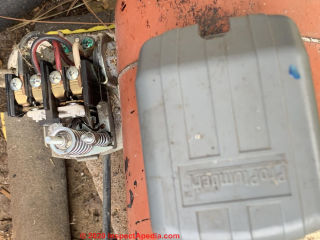
Not quite, though that's a good guess, Andy.
I too would expect a spark at the contacts if there were a load when the switch is closed.
But there could be a switch defect that's less obvious such as badly burned points that simply don't conduct.
So I'd use a VOM or DMM to check power at the input and output terminals.
if proper electrical power is being sent to the pump and it doesn't turn on then the problem could be a failed pump motor, jammed impeller (expect to see current draw), or even an open wire.
More detailed suggestions are given above on this page.
Watch out: if you're not familiar with safe proper electrical work and testing you could be shocked or killed when fooling with live wires and switches.
You can also search InspectApedia.com for SAFE USE of DMMs & VOMs
If there is power coming into the pressure switch and manually closing the contacts makes no change would you suggest the pump has gone bad? I would think there would be a spark at the contacts when manually closed right?
Darl
I hate when the pump gets stuck in the well casing. Usually an experienced well service company can free it up and retrieve it; sometimes they need to send a camera down the well to see exactly what's going on.
Question.
My submersive pump is stuck in the ground it won't come out of the ground.
Just moved into the country and first experience using a well. Taps are dry. Zero pressure. That pump bypass lever did the trick ! thanks so much for posting this information. Keep those tips and tricks coming!
Cheers
Greg,
Check that the air pressure in the tank is below the pump cut in pressure setting.
If so, the problem is probably one of those listed above on this page
Pump (above ground) won't turn on. There is no water pressure. Nor is there air in the air bladder tank. Will putting air in the bladder tank turn the pump on? Water pressure was relieved and air tank was emptied of air to replace pressure switch. Pump worked before.
Donald
First let's follow the wires. Is your pressure control switch turning on the well pump directly or is it turning on a relay in a separate control box which then in turn activates the pump?
My water pump (above ground) does not turn on. Water pressure switch has no debris and had good power. The gauge is also new and free of debris. So, the pressure switch clicks on when pressure falls below kick on position but pump does not run. Tank pressure is good too.
Kate
Great news, and thank you for the follow-up as your report will help other readers.
While it's not the only possible explanation, when tapping the pressure switch turns on the pump I suspect that that small tube or pipe that conducts water pressure to the pressure sensor diaphragm on the pressure switch is getting clogged with silt or rust - or the pinhole pressure port on the bottom of the switch is itself clogging.
You may need to replace the switch and also clean or replace the tube that conducts water pressure to the switch if this problem becomes recurrent.
Thank you so much for this! Got it to work with tapping the switch and opening the switch box.
Shared this page with friends - thank you!
Anon
Try stepping through the diagnostic clues given on the page above
my pump stick and won't start
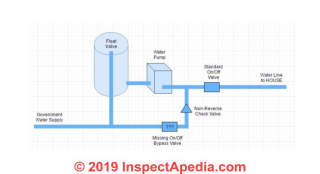 Tom
Tom
Has this problem (pressure boosting pump won't turn on) always been the case since original installation, or did the pump work properly when first installed?
Have a HITACHI WM-P250XS Water Pump. The water comes from the mains and feeds into the inlet to the pump. Also have two tanks that are refilled from the main with float shut off.
Recently the municipality has been reducing the water pressure at night due to a water shortage. In that event the pump is suppose to kick in and draw from the storage tanks. It does not.
However, if I close the bypass valve on the outlet to the house and open it again, the pump will kick in if there is an open water line such as sink or shower.
t will remain on until the water inside the house is turned off. It will not go on again automatically. Some have suggested that the water pressure switch has to be adjusted. We bought a new one and installed but no change.
Any thoughts? I am baffled why shutting the PVC shut off valve would allow the pump to trigger. Some have suggested it lowers the pressure but I would think it would increase the pressure.
If the breaker is tripping that sounds as if there's a short circuit on the pump circuit or the pump motor is seized.
Mouse shorted out pressure switch, changed pressure switch.now breaker keeps kicking off . No water
Emmanuel
Watch out: what you describe is a fire and shock hazard - it sounds as if the electric motor has failed, jammed, or is receiving low voltage - all of which are unsafe; the circuit powering the motor should be turned off.
pls, what about in a case where the pumping machine is somehow hot and is making noise but not rolling.
Anon
If there is power to the pump control relay
AND
if the water pressure is below the pump cut-in pressure (typically 20 or 30 psi)
First try tapping on the pressure control switch: sometimes debris clogging of the switch sensor port causes it to fail to respond to pressure drop, or the contacts may be burned;
If the contacts are closed, sending power to the pump and the pump doesn't run
CHeck for a reset-lever on the side of the pressure control switch
Check for a reset button on the pump motor - not usually present
If none of these get the pump running you need more-detailed diagnostics of the pump, motor, impeller, wiring and circuit.
Those are given exhaustively in the article above on this page.
My well pump will not turn on after being off for seven to nine days during the 2019 polar vortex. What do I do to get it running? I have power at the switch.
Question: lost all water pressure
(July 8, 2014) tony said:
i have lost all water pressure. when i turn the mair valve off the press gauge will go up to 40psi. however when the valve is opened the gauge goes to 0..new pressure switch about 2 weeks old.
I have no water at all
Reply:
Tony
We give lost water pressure diagnostics at
inspectapedia.com/water/Water_Pump_Repair_Guide.php
For the case you describe, turning the main valve off is stopping output from the pressure tank into your building.
As you see water pressure with the main valve off, that suggests that water is running in your building or there is a burst pipe - but that's just guessing from your brief question.
Also see PUMP WON'T START
Anonymous: please search InspectApedia.com for NO WATER PRESSURE to see a recommended list of checkpoints and repairs to fix the trouble.
Anonymous on Sept 3: search InspectApedia for PUMP WON'T STOP RUNNING to see how to diagnose and cure that problem.
Question: water pressure slowly falls to zero, recovers after about 45 minutes
(Apr 1, 2014) Ray said:
The water at my home runs for about 5 to 8 minutes then it slowly stops. I turn the sink back on and still no water, after about 45 minutes I have water again what could be cause
(Apr 2, 2014) John Hernandez said:
I purchase a DAB water pump i'm having a problem with cut in and cut off the pressure guage needle drops to zero before it cuts in i tried adjusting it no results.Can you help me?
Reply: signs of a debris-clogged water pressure control switch sensor port or pressure gauge
Ray, Check these key diagnostic approaches
- WATER PRESSURE TABLE 1: PUMP WON'T RUN, WON'T STOP, or CYCLES
- WATER PRESSURE TABLE 2: PUMP RUNS, WEAK or NO WATER PRESSURE
- WATER PRESSURE TABLE 3: PUMP RUNS, NO WATER or INSUFFICIENT WATER
- WELL WATER PRESSURE DIAGNOSIS
your well may be running out of water but it makes sense first to go through the diagnostic steps suggested in those articles.
John
Check to see if the pump pressure switch sensor port on the switch bottom, or its mounting/pressure sensing tube are dirt clogged. There could also be a sticking relay. In those cases replace the switch and its mounting tube.
Question: dirty water, pump won't shut off
(Mar 29, 2015) M A Rizvi said:
Boring 4" depth 180ft Pump located at 90ft but water is dirty (sand & mud). Pump is running continuously since 12hrs but discharge is not clear. Boring location is Husainabad,Lucknow. Please advise.
Reply:
Your well flow rate or pump are unable to satisfy the pressure setting on your pump control. Or perhaps the debris has clogged the pressure sensor port on the pressure control switch. You should turn off the system before ruining the pump. Then check for debris clogging.
Turn off the pump to avoid burning up the motor.
...
Continue reading at WATER PUMP PRESSURE SWITCH REPAIRS or select a topic from the closely-related articles below, or see the complete ARTICLE INDEX.
Or see WATER PUMP WON'T START FAQs - questions and answers posted originally on this page.
Or see these
Recommended Articles
- NO WATER PRESSURE - other causes besides a bad pump or pump control
- WATER PUMP PRESSURE CONTROL SWITCH - home
- WATER PRESSURE PROBLEM DIAGNOSIS TABLE - diagnostic Table 1: Pump Won't Run, Wont' Stop Running, or Cycles Rapidly
- WATER PRESSURE LOSS DIAGNOSIS & REPAIR - home
- WATER PUMP RELAY SWITCH
- WATER PUMP REPAIR GUIDE - home
- WATER PUMP SHORT CYCLING
- WATER PUMP WON'T START
- WATER PUMP WONT STOP RUNNING - water pump runs continuously
- WATER PRESSURE TABLE 1: PUMP WON'T RUN, WON'T STOP, or CYCLES
- WATER PRESSURE TABLE 2: PUMP RUNS, WEAK or NO WATER PRESSURE
- WATER PRESSURE TABLE 3: PUMP RUNS, NO WATER or INSUFFICIENT WATER
- WATER TANK: USES, TROUBLESHOOTING - home
- WELL PIPING REPAIRS - separate article
Suggested citation for this web page
WATER PUMP WON'T START at InspectApedia.com - online encyclopedia of building & environmental inspection, testing, diagnosis, repair, & problem prevention advice.
Or see this
INDEX to RELATED ARTICLES: ARTICLE INDEX to WATER SUPPLY, PUMPS TANKS WELLS
Or use the SEARCH BOX found below to Ask a Question or Search InspectApedia
...
Ask a Question or Search InspectApedia
Try the search box just below, or if you prefer, post a question or comment in the Comments box below and we will respond promptly.
Search the InspectApedia website
Note: appearance of your Comment below may be delayed: if your comment contains an image, web link, or text that looks to the software as if it might be a web link, your posting will appear after it has been approved by a moderator. Apologies for the delay. Our Comment Box is provided by Countable Web Productions countable.ca
Technical Reviewers & References
Click to Show or Hide Citations & References
Source: https://inspectapedia.com/water/Water-Pump-Wont-Turn-On.php
0 Response to "Can a Square D 9013 Pressure Switch Be Wired With the Line Feeds to the Inside Terminals"
Post a Comment